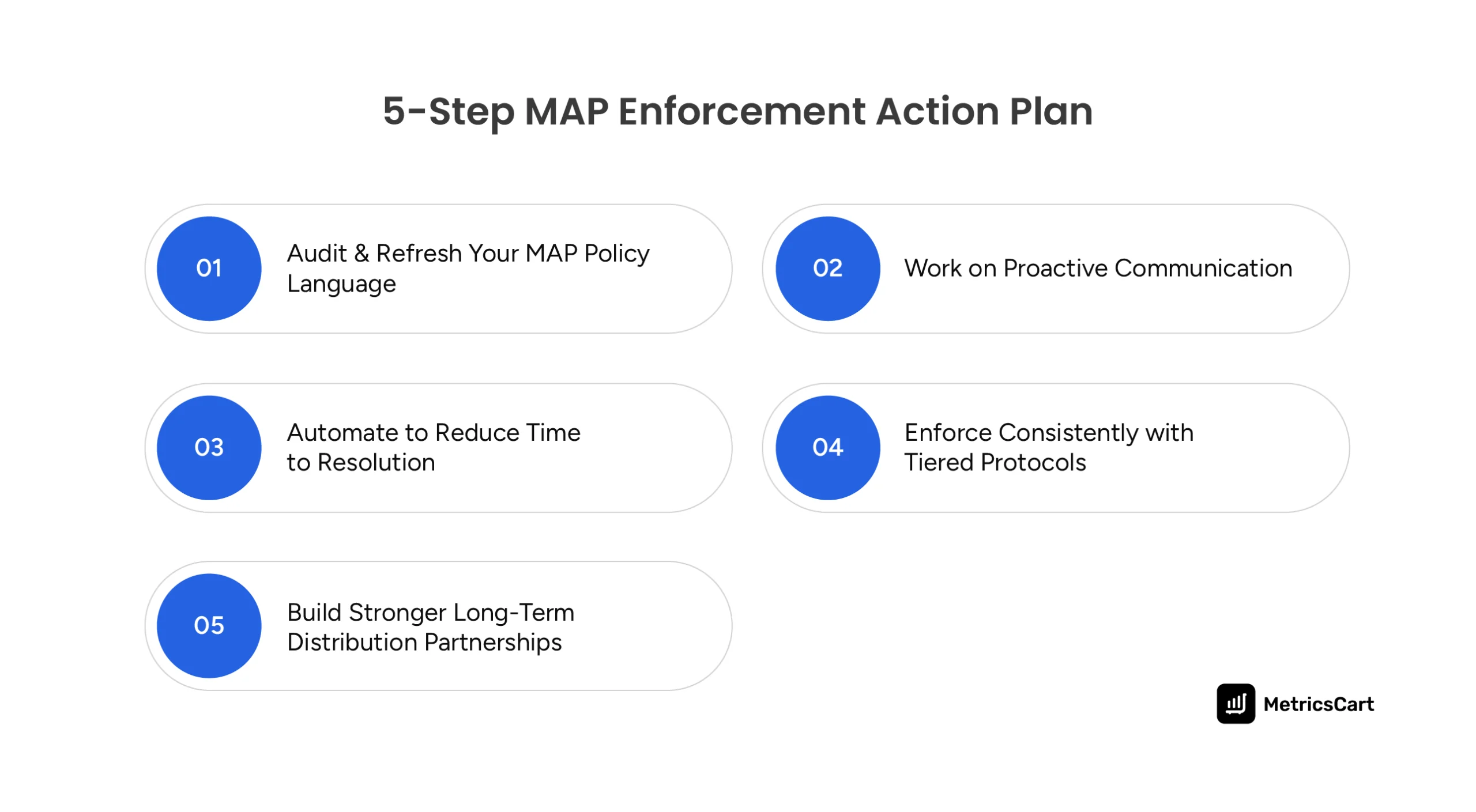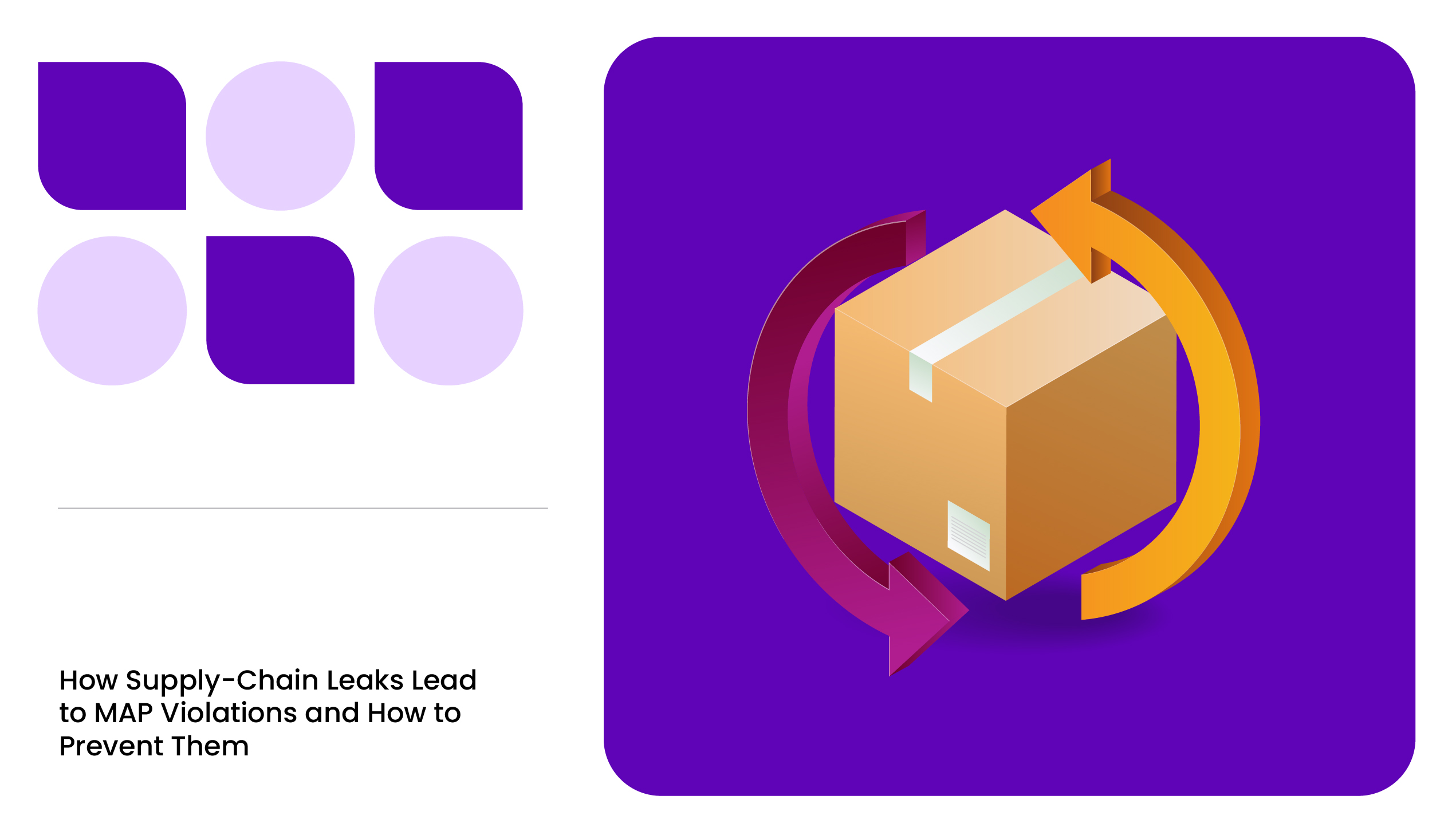The pricing landscape looks stable from the outside, but anyone managing MAP knows it’s chaos. One unauthorized seller drops the price, an AI repricer matches it, and suddenly the entire channel is in a race to the bottom. And with AI-driven repricers, tariffs, third-party sellers, and grey market players, pricing control becomes a constant battle rather than a predictable process.
For years, brands tried to handle MAP enforcement by sending warning emails and assuming sellers would comply. That worked when e-commerce was slower and more contained. But that is not enough in 2025, as e-commerce today operates as a multi-market, always-on ecosystem, and price changes can replicate across platforms in minutes. Marketplace dynamics, cross-border selling, and unauthorized resellers have made enforcement more complex and more essential.
In this blog, let’s walk you through five tactical MAP enforcement steps for 2025. These strategies are designed to strengthen MAP enforcement across platforms like Amazon and Walmart, enhance MAP compliance, and safeguard your pricing integrity at scale.
5 Tactical MAP Enforcement Steps You Must Do in 2025
Here are the essential actions every brand needs to take to maintain pricing control in an always-on e-commerce ecosystem.

Step 1: Audit & Refresh Your MAP Policy Language
Enforcement begins with clarity. A vague or outdated policy is a big red flag. You must regularly revisit your MAP policy documentation to ensure it accurately reflects the realities of online marketplaces, including AI-driven repricing, flash sales, and unauthorized bundling tactics.
Without a clearly defined and enforceable MAP policy, even the best tools or systems won’t prevent pricing erosion.
Here are some best practices to improve MAP compliance in 2025:
- Clearly define terms such as MSRP vs. MAP, “advertised price,” “promotional activity,” and “authorized reseller.”
- Include clauses tailored to specific platforms like Amazon, Walmart, Target Plus, and DTC websites.
- Add legal language that explicitly permits enforcement actions such as delisting or termination.
- Address hybrid violations (e.g., discount codes applied at checkout, multi-unit bundles).
- Ensure all reseller agreements require MAP adherence as a condition of partnership.
Bonus tip: Maintain a version-controlled MAP policy library with change logs to protect against legal challenges and maintain transparency.
READ MORE| Is your MAP enforcement strategy foolproof? To know more, check out MAP Policy Enforcement for Brands: Avoid These 10 Common Mistakes.
Step 2: Work on Proactive Communication
MAP enforcement isn’t only about policy; it’s about messaging. Even compliant sellers can violate MAP if they’re misinformed or under-trained. To reduce violations, you must build communication processes that scale across diverse seller profiles and marketplaces.
This includes clear onboarding, timely updates, and reinforcing MAP compliance expectations. A proactive approach reduces violations and builds partner trust.
Some effective communication practices to strengthen MAP enforcement include:
- Require MAP acknowledgment during onboarding for every new reseller to confirm their understanding.
- Create tailored MAP education decks with examples of violations, screenshots, and compliance FAQs.
- Use CRM-integrated email workflows to push MAP updates when products launch or policies change.
- Translate communications for regional sellers and include visual examples to improve clarity.
- Include MAP adherence as a standing agenda item in quarterly distributor calls.
Bonus tip: Segment sellers by region, channel, or size and personalize MAP messaging frequency and format to match their behavior and business model.
Step 3: Automate to Reduce Time to Resolution
When it comes to enforcement, speed is key. Delays between MAP violation detection and response allow violators to damage pricing integrity and gain an unfair market advantage.
An automated MAP monitoring software lets you monitor hundreds of SKUs across marketplaces, detect violations in real-time, and build airtight documentation instantly. It moves MAP enforcement from reactive to predictive, helping reduce manual workload while increasing enforcement success.
Here are a few ways you can reduce TTR for effective MAP enforcement in 2025:
- Deploy real-time MAP monitoring tools that scan top marketplaces multiple times a day.
- Customize violation alerts by SKU, price drop thresholds, and reseller identity.
- Integrate with BI dashboards to visualize trends and generate weekly MAP heatmaps.
- Automatically log timestamps, screenshots, seller details, and violation frequency.
- Configure workflows that escalate repeat offenders directly to your legal or channel teams.
Bonus tip: Use AI-driven analytics to identify repeat violation patterns, such as weekends or promotions, and pre-emptively enforce MAP before issues arise.
READ MORE| Worried about how to tackle Amazon MAP violations? Check out Amazon MAP Policy Violation Is Killing Your Brand Value: Learn How To Detect and Prevent

Step 4: Enforce Consistently with Tiered Protocols
MAP enforcement without consistency is performative. Sellers notice when rules aren’t applied uniformly, and they exploit it. A structured, repeatable MAP enforcement framework ensures accountability across all sellers and minimizes legal risk.
Having a tiered structure, first, notice, second, warning, and third, consequence, not only simplifies internal workflows but also makes sellers think twice before violating.
Here are some consistency boosters that can strengthen MAP enforcement:
- Define your enforcement protocol in writing and circulate it to your internal and partner teams.
- Use legally approved templates for every violation stage to streamline execution.
- Track enforcement metrics like time to response, frequency of action, and seller remediation rate.
- Publish quarterly MAP compliance reports that highlight improvements and identify key risks.
- Establish an appeals process to allow compliant sellers to rectify violations caused by technical errors.
Bonus tip: Use MetricsCart for MAP monitoring and enforcement to automate a tiered enforcement process with predefined violation templates and documented evidence logs so your team acts faster, and your resellers know you mean business.
Step 5: Build Stronger Long-Term Distribution Partnerships
MAP enforcement is easier with aligned partners. Distribution should be a two-way relationship where sellers are incentivized to protect brand value. Your brand must go beyond punitive actions and invest in MAP education, compliance tools, and reward systems.
The goal is to transform sellers into MAP allies who understand that consistent pricing equals stronger long-term performance for everyone.
Some ways to build a stronger distribution network include:
- Include MAP performance as a scorecard metric alongside volume and sell-through rates.
- Create a partner incentive system where top MAP-compliant sellers receive acknowledgment and rewards.
- Offer joint planning meetings to align pricing and promotional strategy.
- Provide training and visibility campaigns for MAP-compliant partners.
- Use MAP adherence as a criterion for participation in exclusive product drops or channel expansions.
Bonus tip: Celebrate MAP-compliant partners publicly to build morale and reinforce healthy reseller behavior.
Strengthen MAP Enforcement: The Next Step is Yours
These MAP policy enforcement tactics for 2025 combine policy clarity, proactive seller engagement, intelligent automation, consistent enforcement, and partner alignment. Brands that adopt such a tactical and system-driven approach will not only protect their margins but also earn greater trust and cooperation from their sales ecosystem.
To truly strengthen MAP enforcement, your tools need to match the complexity of your marketplace. That’s where MetricsCart steps in. From 24/7 price monitoring to real-time violation alerts, automated strike protocols, and built-in documentation templates, MetricsCart simplifies the entire MAP enforcement lifecycle. Ready to protect your brand equity and pricing power? Book a walkthrough now!
Want To Protect Your Brand Reputation From Unauthorized Sellers? Choose MetricsCart
FAQs
Use automated tools to detect violations, use tiered enforcement plans, and document proof. Monitor seller behavior continuously.
Update your policy with platform-specific clauses, define violations clearly, and automate MAP monitoring and enforcement.
Deploy automated MAP monitoring and enforcement tools like MetricsCart for 24/7 scanning, alerts by SKU, and repeat offender tracking for reduced TTR and a healthy pricing ecosystem.
Use educational reseller onboarding, automated updates, and portals for policy access. Reinforce through regular check-ins.
It ensures brand value isn’t diluted by constant price undercutting, helping maintain consistency across all customer touchpoints.







